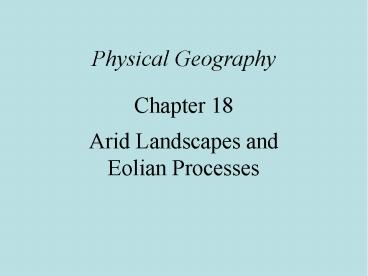Physical Geography Chapter 18 - PowerPoint PPT Presentation
Title:
Physical Geography Chapter 18
Description:
Title: Slide 1 Author: Lawrence McGlinn Last modified by: COAS Created Date: 12/28/2006 2:09:16 AM Document presentation format: On-screen Show (4:3) – PowerPoint PPT presentation
Number of Views:220
Avg rating:3.0/5.0
Title: Physical Geography Chapter 18
1
Physical GeographyChapter 18
Arid Landscapes and Eolian Processes
2
Arid Landscapes Eolian Processes
- Arid Landscapes
- Eolian Erosion Transportation
- Eolian Deposition Landforms
- Human Interactions with Eolian Processes
3
Arid Landscapes
- 3 factors influence arid climates
- Subtropical high pressure
- Rainshadow
- Distance from large bodies of water
4
Desert Geomorphology
- Water important to landforms in arid regions
little vegetation to slow intermittent erosion - Arroyo steep-sided gully cut into alluvium
- In undisturbed, horiz. rock layers more resistant
sandstone or limestone forms flat caprock above
easily eroded shale - Result is landforms flat on top w/steep sides
- Plateau -Canyon -Butte -Mesa
- Pinnacle -Playa
5
Arroyo
6
Desert Landforms
Note Tops of most landforms once part of same
surface, since partially eroded away
7
Playa
8
Eolian Erosion and Transport
- Wind-based processes important in deserts b/c
- Strong winds common in desert
- Large supply of sand silt to be blown
- Vegetation minimal wind free to erode
9
Fluid Behavior of Wind
- Wind acts like a fluid, like water, but less
dense - Faster wind can move larger particles
Threshold Velocity for wind to carry different
sized particles
10
Particle Transport
- Silts and Clays carried in suspension
- Sand bounces along saltation, or
- Sand rolls slowly along creep
11
Eolian Erosional Landforms
- 2 types of wind erosion
- Deflation wind blows loose soil away
- leaves coarser pebbles cobbles, called Desert
Pavement - when deflation causes basin to form, called
Deflation Hollow
12
Eolian Erosional Landforms
- Abrasion wind blows sand along a surface to
polish abrade it - Ventifacts rocks shaped by abrasion pitted,
grooved, polished - Yardangs elongated, wind-sculpted ridges caused
by abrasion
13
Eolian Erosional Landforms
Deflation/Desert Pavement
14
Eolian Erosional Landforms
Abrasion
Ventifacts
Yardangs
15
Loess
- Fine-grained, wind-blown silt high in calcium
usually from alluvial deposits or glacial till - Can be transported farther than sand
16
Loess Deposits around the World
Arid Landscapes and Eolian Processes
17
Loess Terraces
18
Human Impact/Desertification
- Desertification transforming a vegetated
landscape to one that is barren susceptible to
wind erosion - Population pressure has forced more people to
clear marginal, semi-arid-to-arid land for
agriculture firewood - In wind, cleared land loses topsoil and nutrients
- Vegetation unlikely to reestablish
19
Regions Prone to Desertification
20
Desertification in African Sahel
- Semi-arid region in transition region from Sahara
Desert in north to rainforest in south - Traditionally nomadic herders small, sedentary
farmers north-south migrations to follow rain - Into 20th century, European borders resource
exploitation made people more sedentary
over-cultivation of soil, overgrazing, and tree
removal - Add in extended drought since late 1960s, you
have desertification
21
The Sahel
22
Desertification in Great Plains
- Great Plains lie east of Rocky Mts in semi-arid
climate with short grass as dominant natural
vegetation
Dust Bowl Region
23
Desertification in Great Plains
- Early 1900s Americans moved to region to farm,
plowing and clearing native grasses unusually
wet period - 1930s terrible drought hits topsoil blows
into dust storms called Dust Bowl - Many migrated to California elsewhere
- Those who stayed have employed irrigation soil
conservation, including windbreaks, and
conservation tillage

